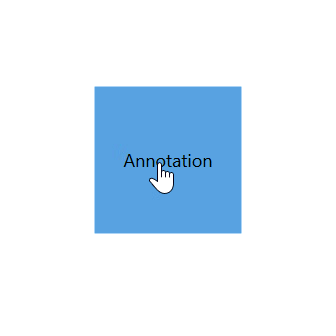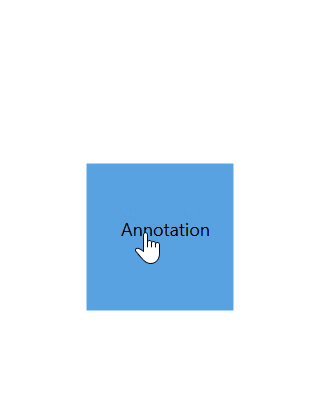- Dragging the annotation
- Nudging an annotation
- How to restrict the dragging area
Contact Support
How to drag the annotation
29 Nov 20243 minutes to read
Dragging process can be applied over annotation and dragging can be controlled by the annotation and its parent node or connector.
To learn about annotation constraints, refer to the Annotation Constraints.
Dragging the annotation
Dragging of annotation can be enabled by using the Constraints property of AnnotationEditorViewModel class and setting its value as AnnotationConstraints.Draggable.
<!--Initialize the Annotation Collection-->
<syncfusion:AnnotationCollection>
<!--Initialize the annotation with draggable constraint-->
<syncfusion:AnnotationEditorViewModel Content="Annotation" Constraints="Draggable"/>
</syncfusion:AnnotationCollection>//Initialize the Annotation Collection
Annotations = new ObservableCollection<IAnnotation>()
{
new AnnotationEditorViewModel()
{
Content = "Annotation",
//Initialize the constraint as draggable
Constraints = AnnotationConstraints.Draggable
}
}
Nudging an annotation
Diagram allows users to nudge annotations by one pixel in a specific direction using the arrow keys. By enabling the AnnotationConstraints.Selectable and AnnotationConstraints.Draggable through the Constraints property in the AnnotationEditorViewModel class, users can interact with annotations and adjust their positions incrementally. Additionally, holding down the shift key while pressing the arrow key will move the annotation ten pixels instead of one.

How to restrict the dragging area
Diagram allows you to specify the amount of dragging area around the annotation by enabling the Constraints as AnnotationConstraints.DragLimit and dragging area can be specified by using the DragLimit property. You cannot drag the annotation behind this drag limit value. Default value is (10, 10, 10, 10).
<!--Initialize the AnnotationCollection-->
<syncfusion:AnnotationCollection>
<!--Initialize the annotation with drag limit value-->
<syncfusion:AnnotationEditorViewModel Content="Annotation"
Constraints="Draggable,DragLimit"
DragLimit="40,80,40,40"/>
</syncfusion:AnnotationCollection>//Initialize the AnnotationCollection
Annotations = new ObservableCollection<IAnnotation>()
{
new AnnotationEditorViewModel()
{
Content = "Annotation",
//Initialize the drag limit constraint
Constraints = AnnotationConstraints.Draggable | AnnotationConstraints.DragLimit,
//Initialize the drag limit value
DragLimit = new Thickness(40,80,40,40),
}
}| Property | Value | Output | Keyboard Output |
|---|---|---|---|
| DragLimit | (10,10,10,10) |  |
 |
| (40,80,40,40) |  |
 |